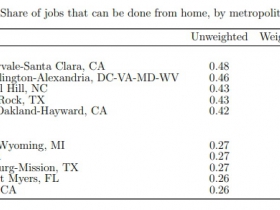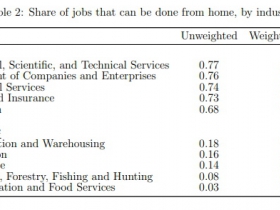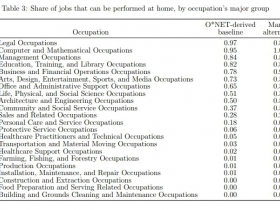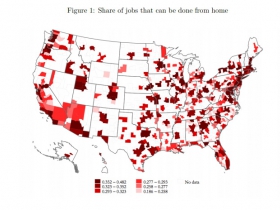How Many Milwaukeeans Can Work From Home?
City ranks far behind Madison, but ahead of national average and state's other metro areas.
If you’re a software engineer, financial analyst or journalist, working from home is almost certainly possible. But if you’re a truck driver, mason or retail clerk, it’s not even a consideration.
A new white paper from the University of Chicago attempts to quantify what percentage of workers in a metropolitan area can be expected to work from home with the COVID-19 pandemic drastically altering the United States economy.
“Identifying which jobs cannot be performed from home may be useful as policymakers try to target social insurance payments to those that most need them,” write authors Jonathan Dingel and Brent Neiman.
Milwaukee, despite its blue-collar, industrial heritage, scores better than 75 percent of the nation’s metro areas in terms of the percentage of the workforce that could work from home. The Milwaukee-Waukesha-West Allis area ranks 88th out of 395 metro areas.
At 34.1 percent of jobs able to be performed from home, Milwaukee is slightly above the national average of 34 percent. Its peers include Pittsburgh, New Haven, Jacksonville, Nashville and Charleston, WV.
That figure would mean 265,156 of the region’s 777,585 reported workers could be currently working from home.
But that rate is far behind national leaders like San Jose (48.2 percent), Washington DC (46.3), Trenton (45.4), Boulder (45), Durham (43.4), Austin (42.6), San Francisco (41.9) and Boston (41.4).
Green Bay (31.7), La Crosse (30.7), Oshkosh (30.3), Appleton (30), Janesville-Beloit (28.2), Wausau (28.2), Eau Claire (28.1), Sheboygan (26.5), Racine (25) and Fond du Lac (24.5) are also included in the report. Kenosha is included in the Chicago area (36.8)
The authors looked at the percentage of jobs in each field that could be done at home according to Occupational Information Network surveys and matched that with U.S. Census Bureau data regarding the number of jobs in each sector in each metro area.
“As shown in Table 2 [included below], whereas most jobs in finance, corporate management, and professional and scientific services could plausibly be performed at home, very few jobs in agriculture, hotels and restaurants, or retail could be,” wrote the authors.
The study also assigned weighting to each sector based on pay and attempted to quantify what percentage of the region’s wages could be earned by those working from home. Milwaukee rises to 58th overall in that measure, with 44.2 percent of the region’s wages going to those who can work from home. Madison falls to 28th with 48.8 percent. The leader remains San Jose, the southern anchor of Silicon Valley, with 63.4 percent.
The Milwaukee-Waukesha-West Allis combined statistical area used in the study includes all of Milwaukee, Waukesha, Ozaukee and Washington counties.
If you think stories like this are important, become a member of Urban Milwaukee and help support real, independent journalism. Plus you get some cool added benefits.
More about the Coronavirus Pandemic
- Governors Tony Evers, JB Pritzker, Tim Walz, and Gretchen Whitmer Issue a Joint Statement Concerning Reports that Donald Trump Gave Russian Dictator Putin American COVID-19 Supplies - Gov. Tony Evers - Oct 11th, 2024
- MHD Release: Milwaukee Health Department Launches COVID-19 Wastewater Testing Dashboard - City of Milwaukee Health Department - Jan 23rd, 2024
- Milwaukee County Announces New Policies Related to COVID-19 Pandemic - David Crowley - May 9th, 2023
- DHS Details End of Emergency COVID-19 Response - Wisconsin Department of Health Services - Apr 26th, 2023
- Milwaukee Health Department Announces Upcoming Changes to COVID-19 Services - City of Milwaukee Health Department - Mar 17th, 2023
- Fitzgerald Applauds Passage of COVID-19 Origin Act - U.S. Rep. Scott Fitzgerald - Mar 10th, 2023
- DHS Expands Free COVID-19 Testing Program - Wisconsin Department of Health Services - Feb 10th, 2023
- MKE County: COVID-19 Hospitalizations Rising - Graham Kilmer - Jan 16th, 2023
- Not Enough Getting Bivalent Booster Shots, State Health Officials Warn - Gaby Vinick - Dec 26th, 2022
- Nearly All Wisconsinites Age 6 Months and Older Now Eligible for Updated COVID-19 Vaccine - Wisconsin Department of Health Services - Dec 15th, 2022
Read more about Coronavirus Pandemic here


























